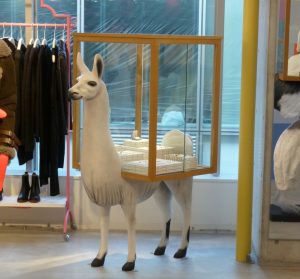ACROSS: What can the participants expect from the Umdasch Shop Expedition from November 14 to 18, 2016, in Tokyo?
CHRISTIAN MIKUNDA: This is already Umdasch Shopfitting’s fifth shop dramaturgy learning expedition in the Japanese capital. Let me explain briefly how a learning expedition is set up. Think of them as stop-by-stop dramas, like traveling lectures. My wife and I hold lectures every morning to freshen up the participant’s theoretical background. We want to immerse them in the happenings in the store on site in three dimensions. A learning expedition is therefore not a classic “check-out-the-store” tour of the kind offered by many others. We do not stand in front of a store to simply to say “This is really great here.” Rather, we explain, before we enter the store, what psychological mechanisms and dramaturgical stagings play a role there. In this way, participants can become part of the quasi three-dimensional piece of theater that each store holds in store for them.
ACROSS: Why Tokyo, exactly?
MIKUNDA: There is no place else in the world that does shop theater better than Tokyo. Tokyo is by far the most interesting retail city in all the world. This also includes terms of ranges. Nowhere else is there such great variety of men’s clothing. The reason is that the Japanese are very slim. The Japanese capital therefore has several department stores exclusively for men’s fashion for 18- to 35-year-olds. Likewise, there is an incredible variety of girlie fashion; at the forefront of this is the 12-story, “Shibuya 109” where 13- to 19-year-old girls are the target group. People experience the greatest dopamine release in the world there (laughs).
ACROSS: You set great store by the mixing of shop dramaturgy and everyday culture on learning expeditions, right?
MIKUNDA: Yes, that’s why we visit a Maid Café in Tokyo as well. Young men go there if they don’t get a date but still want to flirt. The women there, dressed as 19th-century maids, flirt with the men for money. These maid cafes are the instructions for understanding “Shibuya 109.” The saleswomen are dressed just like the dolls standing beside them and the customers, naturally, look similar. That’s spooky (laughs). From this mixture of all forms of staging, we show that everyone everywhere uses the same tricks.
ACROSS: What other highlights does the Japanese capital have to offer?
MIKUNDA: Tokyo is the world capital of freestanding flagship stores, like that of Prada. But there are also great “joy shops,” like “Shibuya 109,” and unique concept stores, like Dover Street Market, the original of which is located in London. Above all, though, is the absolutely ludicrous shop theater to be found in Tokyo. Just think of the 10-story Uniqlo store in Ginza, with 60 rotating dolls in a showcase.
ACROSS: How are the stores guarding against competition from online retail?

MIKUNDA: The stationary trade is rolling out the big guns in the form of experiences that can strengthen it against the online threat. That’s why stores like “Opening Ceremony,” have llamas or other artificial animals act as merchandise holders. People like us have to look three times to understand what’s happening there. The idea behind these is to target subconscious trance effects or hypnotic aesthetics. This attracts customers indirectly. It’s a subliminal attraction. Many shops in Tokyo rely on such effects. The city is a laboratory for shop theater. Nowhere else in the world one has stiffer competition in that regard, not even London or New York.
ACROSS: You’re leading another Umdasch Shopfitting learning expedition, namely “Cruise into to the World of Shop Dramaturgy” onboard the “Harmony of the Seas” on October 20 to 23, 2016. What is the idea behind that?
MIKUNDA: In 2013, we organized a trip around the world under the motto, “Around the World in 18 days,” in which we spent two days aboard the “Allure of the Seas.” Her sister ship, the, “Harmony of the Seas” was recently launched. It is now the world’s largest cruise ship. It will only sail the Mediterranean during the first few months before heading to the Caribbean. We’re using this unique opportunity for a short cruise with the “Harmony of the Seas” for our journey.
ACROSS: What stops await on the short cruise?
MIKUNDA: It begins on October 20 in Civitavecchia, the port for Rome, where it first departs. The next day, we anchor at Capri, followed by a day at sea. On the morning of October 23, the “Harmony of the Seas” finally reaches Barcelona.

Credit: Peter U. Geisler / RCL Cruises
ACROSS: What makes the “Harmony of the Seas” so special for the participants on your trip?
MIKUNDA: One example is the bar where the cocktails are mixed by industrial robots. The world’s largest entertainment slide—it extends down 10 decks—is another highlight on board. Then there is the 800-seat open-air theater, the world’s largest on a ship. Not to mention its Central Park with 6,000 trees and shrubs.
ACROSS: How is this trip set up?
MIKUNDA: As with any of Umdasch Shopfitting’s learning expeditions, I hold a lecture on shop dramaturgy at the beginning. We then show the participants the fantastic flagship stores of Rome, like the famous one from Luis Vuitton, designed by Peter Marino. The American architect is building almost all the luxury shops in the world at the moment. We show how his great glory productions work. The Italian capital also trumps with an outstanding Zara flagship store; a multistory, white-on-white construction in a palace. We also head to interesting shoe productions, such as Valentino and Stuart Weitzman. After that, we climb aboard the “Harmony of the Seas.” The participants then have the next day off, so to speak. They do receive a briefing from us on the small shops on Capri. There they see that shop dramaturgy can work perfectly well in a small space.
ACROSS: What happens on day three?
MIKUNDA: We explain how entertainment and shopping work together during a detailed tour of the huge ship. This interaction is particularly important when stores are located in large urban entertainment centers such as airports, railway stations, and even cruise ships. The shop dramaturgy is of course very special in this case. The “Harmony of the Seas” features, among other things, so-called art priming, in which works of art create an emotional environment. This is only a pre-show before the actual show, however. One fine example of this kind of priming is the 70 ball gowns that fly through the atrium. In total, there are 8,500 works of art on the ship that create a lifestyle environment. The “Harmony of the Seas” shows the pinnacle of the current possibilities for dramaturgy.
ACROSS: What can participants expect in Barcelona?
MIKUNDA: We know which stores are open in the Catalan capital on October 23—a Sunday. On this full-day bus tour, we once again take great care to ensure that everyday culture is as much a part of the tour as the stores themselves. We therefore show how Gaudí’s signature is reflected in a Desigual store. We also visit a hypno-aesthetic H&M and a Replay store where the clothes hang from cables spanning the room. The tour then takes us to the Nike store in the Camp Nou football stadium. This four-story sports shop works very professionally on personalization. We also visit small shops in the Gothic Quarter, however, where the designers themselves are in the shop. After that, the participants head off to the airport.
Christian Mikunda, Credit: Comment / Christian Mikunda
On behalf of Umdasch Shopfitting, the Vienna shop dramaturge and retail professional familiarizes participants with the new wonders of world shop theatrics from around the globe. From October 20 to 23, participants will travel from Rome to Barcelona on the “Harmony of the Seas.” The learning expedition to Tokyo then takes place from November 14 to 18.
More information: Umdasch Shop Academy






